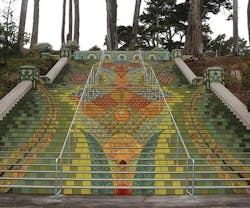In April, Aileen Barr walked across the stage at Coverings in Chicago, IL, to accept the grand prize for a tiled project. The grandiose 100-year-old staircase leading up to San Francisco’s Lincoln Park—completed in conjunction with Doty Tile and Snyder Tile—takes inspiration from the Arts and Crafts movement and Art Deco, blossoming up the riser of the stairs with a vibrant bouquet of flora. The artwork was created by hand—each piece lovingly crafted by Barr herself— and flanked by square filler tiles produced by Fireclay and Heath Ceramics.
The project was made possible through the purchase of donor tiles within the artwork, and sponsorship from the San Francisco Parks Alliance and the San Francisco Recreation and Parks Department, as well as by a grant from the City of San Francisco.
We sat down with Barr to discuss the trials and tribulations of creating a tiled masterpiece for one of San Francisco’s historic icons.
interiors+sources: Will you speak a little more about the project and how you became involved?
Aileen Barr: The staircase itself is located at the end of California Street in San Francisco, and it goes up into Lincoln Park. At the bottom
of the staircase there’s a school. It was parents from that school who wanted to create a decorative tile staircase as part of their centennial celebration for the school.
i+s: How were the tiles installed to the original staircase?
AB: The staircase itself was built in 1916. It was an old concrete staircase. So the tiles are adhered and set onto that substrate. [We used Schluter-] Ditra, a system for crack suppression that adheres to the back. So you have the concrete, the Ditra, then the tiles are thinsetted to the Ditra.
Because it’s such an old staircase, each flight was slightly off from the last. Once the art tiles were applied, then the flat tiles were put around it. And all of that color was made by Fireclay, which is a tile company in the area—in San Jose. And that was all made to order.
i+s: Why did you go with Fireclay?
AB: They do a lot of recycling, and their colors really fit the types of colors I was using in my art tile. So the two products really fit each other. And because they’re local. It’s nice to use local companies.
i+s: Were they the only other tile company you used?
AB: No. On the pillars, the art tiles are in the central part of it, then I used Heath Tile to fill around them. Heath Tile is another local company in Sausalito. They have a huge collection, so I would go there and find the colors I wanted. I collected them over the course of six months since we had a limited budget.
i+s: Had you used these companies before?
AB: It was the first time I had used Fireclay. I have used Heath Ceramics before for another tile stairs project. The first one that I did was on 16th Avenue in San Francisco.
i+s: Was there any difficulty in using two different companies and being able to match the colors?
AB: No, because my pallet was quite limited. It worked really well together.
i+s: What were some of the issues you came across?
AB: Since we were using an original staircase that was built in the 1900s, there was nosing that had to be sawed off the whole way across. Because the tiles are adhered to the riser part—the upright part of the stair—when we had to saw off all that nosing, in some areas that substrate wasn’t completely flat. So they had to be flattened out. The installation took longer than expected because of those kinds of problems. And then there was cracking on the concrete as well, which is why we ended up using the Ditra.
About the Author

Kadie Yale
Former Editor-in-Chief
Kadie Yale holds a BA in Industrial Design from San Francisco State University and a MA in Decorative Art History and Theory from Parsons the New School. In her role as editor-in-chief from 2015-2018, she led the interiors+sources team in creating relevant content that touches on sustainability, universal design, science, and the role of design in society.
